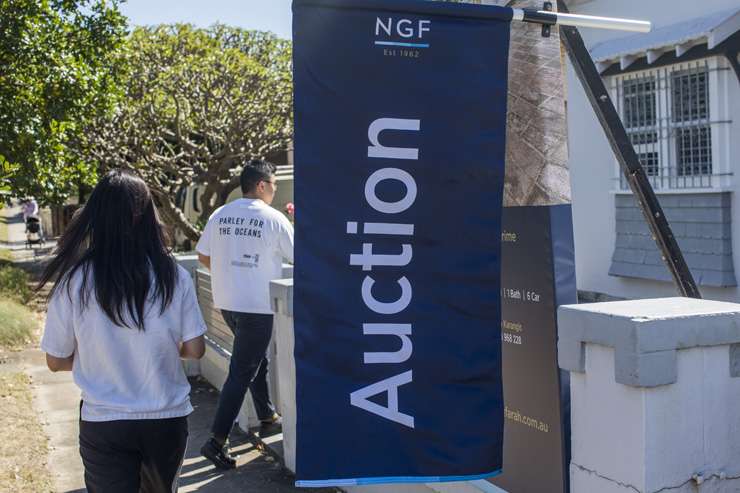CoreLogic’s head of research in New Zealand is picking the housing market downturn is only three months away from coming to an end.
Nick Goodall says statistics for March show the Australian market has already started to pick up ahead of New Zealand.
While New Zealand’s market is still falling, CoreLogic Australia’s home value index for March posted the first month on month rise since April, 2022, with prices up .6%.
Values were higher across the four largest capital cities in Australia and other areas, led by a 1.4% gain in Sydney.
Start your property search
Goodall says the big reason Australia is rallying first comes down to differing stock levels in the two countries.
Australia has lower listings numbers which leads to increased competition, and that means higher prices.
New Zealand, however, has the highest number of listings seen for two or three years and Goodall says the reason stock levels here are so high is because sales volumes dropped away so much over the last 15 months since the peak of the market.
“What it means is that we wouldn't have the same level of competition driving prices up,” he says.
“Demand has been reduced to similar levels in both countries but the difference is demand over there is for fewer properties while demand here is for more properties.
Read more:
- Downturn looks to be coming to an end in Canterbury
- Why some landlords expect National to bring in a capital gains tax
- How NZ has dodged a global property crisis
“They just haven't had the same trend in Australia and that probably is the one big difference which might see their downturn end sooner than it does here.”
While Goodall says Australia’s 0.6% lift nationwide is a noticeable change in trend, he also says that’s only for one month so it’s early days.
“But I think when it's supported by other things - auction clearance rates have increased as well - there's probably a level of reality to it.”
He does not think New Zealand is far behind: “I think because that tightening cycle from an interest rate perspective, we're pretty close to being in a similar position to them now in terms of OCR increases likely to come to an end soon.
“Mortgage interest rates have peaked already much the same as Australia, so I'd say we're probably only three months behind them in terms of the market downturn coming to an end.”
Another reason playing into Australia’s bounce ahead of New Zealand is the difference in Reserve Bank activity between the two countries, Goodall says.
New Zealand has been more aggressive in its hiking of the OCR, which started earlier than in Australia, whereas the Australian Reserve Bank has been less aggressive.
“In Australia, they've certainly slowed down their thinking more so than our guys. “
CoreLogic’s head of Australian research, Eliza Owen, says the Reserve Bank of Australia opted for a lower emergency-level low in the cash rate target of 0.1% through the pandemic, compared to .25% from the Reserve Bank of New Zealand.
She says nationally, home values across New Zealand had a larger boom than in Australia.
“This might also be requiring the RBNZ to go tougher on the cash rate, to stem the impact of wealth effects from high home values.”

CoreLogic head research Nick Goodall says lower stock levels in Australia have supported price increases there. Photo / Supplied
Despite the sharper uplift in the New Zealand OCR, New Zealand home values have sustained a larger boom in value since the onset of the pandemic, she says.
“Home values across Australia remain 15% higher across Australia than in March 2020, while NZ home values are sitting around 28% higher.
“This also means the premium between the average NZ home value and AU median home value has virtually doubled.”
Owen says home values are continuing to fall fast in New Zealand with total stock levels accumulating, compared to Australian stock levels remaining relatively tight with home values starting to rise as of last month.
“Australia may now be moving through the trough of the cycle, though there are still some uncertainties ahead.”
Owen says further rate rises could still come in Australia where labour market conditions remain tight and household consumption is only just starting to ease from stubbornly high levels and that could create some downward pressure on the market over the year ahead.
Nerida Conisbee, Ray White’s chief economist, says New Zealand’s higher interest rate rises are a key reason for Australia bouncing back faster.
Higher rates make it more difficult and expensive to get finance, she says, but she also says population growth across the Tasman is a factor.
“Population growth has jumped back to pre-pandemic levels in Aus. This is leading to rents growing at their fastest rate ever recorded and is now spilling across to the buyer market.”

Auction clearance rates in Australia are on the up – can a revival in New Zealand be far behind? Photo / Getty Images
Conisbee says New Zealand saw a contraction in its economy in the December quarter, which may mean recession and recession is not good news for housing markets.
Confidence is also likely lower in New Zealand due to the higher interest rates, economic contractions and the weather events at the start of the year, she says.
Conisbee also says Australia’s construction crisis is declining as are the number of homes being build, and that, combined with strong population growth, is leading to a severe housing shortage which is showing up in rental growth.
Another house price index in Australia, the PropTrack Home Price Index, also shows property values were up in most capital cities in March, according to a realestate.com.au report.
The website reports a PropTrack senior economist saying home prices lifted nationally by .13% in March, making them .49% higher this year and that the downward trend had reversed.
“We saw price falls easing into the end of 2022 and now things are moving upwards again,” said Elanor Creagh.
While prices fell from their peaks in the first half of last year on the back of rapid interest rate increases but that impact had been significantly blunted in more recent months.
“Even though buyer demand is weaker than peak levels, softness in new listing volumes and tight supply have offset this.
“That’s led to a pick-up in competition among potential buyers, buoying home values.”
Creagh warned, though, that the decline of prices in Australia could still see a second wind, particularly if new listing volumes increased in the months ahead.












































































